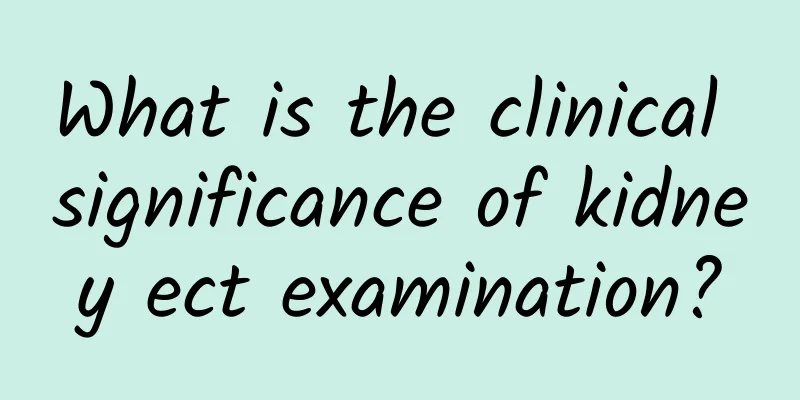What is the clinical significance of kidney ect examination?

|
Kidney ECT is a single photon emission computed tomography scanner, which uses radioactive elements to conduct physical examinations, mainly to check kidney function. Its advantage is that it can check kidney function without intubation, and it can achieve good examination effects on glomerulonephritis, nephrotic syndrome, primary hypertension, etc. Clinical Application 1. Renal function test Its advantage is that it can reflect renal function without ureteral catheterization. Renal impairment caused by glomerulonephritis, nephrotic syndrome and essential hypertension often affects both kidneys, so the renal image shows bilateral renal impairment. Renal tuberculosis, partial pyelonephritis, unilateral renal artery stenosis, renal tumors, etc. are often caused by unilateral renal damage. Renal imaging is used to assist in the diagnosis of the above-mentioned lesions, determine the degree of renal damage, and is helpful for staging the disease, guiding and observing the therapeutic effect. 2. Diagnosis of upper urinary tract obstruction The diagnostic sensitivity of upper urinary tract obstruction is about 80-90%. When there is no concomitant renal impairment, the diagnostic sensitivity of obstruction is equivalent to that of X-ray venography IVP. However, when renal impairment occurs, IVP cannot be visualized in some patients, while ECT can be visualized as long as there is 3% residual renal function. 3. Diagnosis of unilateral renovascular hypertension Renal hypertension includes renal vascular hypertension and renal parenchymal disease-induced hypertension. If one side of the kidney has poor blood perfusion, the renal shadow is significantly smaller than the other side, and the clearance of radioactivity in the renal parenchyma is delayed, then the possibility of renal vascular hypertension is very high. Dozens of reports have shown that the true positive rate of renal function imaging is 54-100%?85%?. The Captopril test further improves the diagnostic accuracy. 4. Kidney transplant monitoring The main complications after transplantation are acute tubular necrosis and rejection reaction. Since renal imaging can comprehensively observe various conditions before, after and after the kidney, and is a non-invasive examination, it is listed as a routine monitoring method for renal transplantation abroad. The first examination is performed within 24 hours after transplantation. If the results are basically normal, it indicates that the transplantation is successful. If there is no perfusion and function within a few hours, it indicates that the transplantation is unsuccessful and the transplanted kidney should be removed immediately. The second examination should be performed within 5 to 6 days to detect acute rejection reaction in time, and then the examination should be carried out according to the condition to detect complications in time and treat them in time. Significance of the results Renal ECT measures the glomerular filtration rate, which refers to the ability of the kidney to clear a substance from the plasma per unit time. The glomerular filtration rate is usually measured as clearance, which is used to calculate how many milliliters of plasma the kidneys can clear of the substance per minute and is corrected for body surface area. Serum creatinine alone is not accurate enough to reflect GFR. In the past, GFR was mostly assessed clinically by measuring creatinine clearance using blood or urine samples. The average normal value is around 100±10ml/min, which is slightly lower in women than in men. The results of renal ECT are significant in terms of glomerular filtration rate. The ratio of glomerular filtration rate to renal plasma flow is called filtration fraction. The renal plasma flow is about 660 ml per minute, so the filtration fraction is 125/660×100%≈19%. This result indicates that about 1/5 of the plasma flowing through the kidney is filtered into the cystic cavity by the glomerulus to form primary urine. Glomerular filtration rate and filtration fraction are measures of kidney function. When the glomerular filtration rate is lower than normal and reaches 60 ml/min, it is considered to be in the third stage of chronic renal failure and requires serious treatment. In particular, it can provide information on renal function on each side and patency of the upper urinary tract on each side, which can help detect kidney damage at an early stage. |
<<: What causes itchy buttocks?
Recommend
What is the reason for scanty menstrual blood?
Everyone knows that women's menstruation is a...
How to treat fleas and mosquitoes
Mosquitoes and fleas are common pests in our live...
There is a red patch on the glans penis which is not painful or itchy
The penis is an important reproductive and sexual...
What are the methods of traditional Chinese medicine for treating gallbladder cancer?
Traditional treatments for cancer generally follo...
Can I use an IUD during breastfeeding?
As we all know, when women are breastfeeding, the...
How to treat a baby with a sallow complexion and thin body
Basically every parent hopes that their child is ...
What is Panax notoginseng?
Panax notoginseng is a relatively common Chinese ...
Functions of histone methylation
Everyone wants to be healthy and live a long life...
What causes liver pain sometimes?
Some people often feel pain in the liver area whe...
Can hair loss caused by stress be restored?
Staying up late, high stress, and unhealthy lifes...
Varicella vaccination schedule
Vaccines are not only to keep children away from ...
The best recipe for soaking Cistanche deserticola in wine
Cistanche deserticola is a Chinese herbal medicin...
How to clear blood vessel blockage
Blood vessel blockage is harmful to human health....
Can you eat deformed cherries?
When we buy fruits, we always find that the appea...
Spleen and stomach deficiency heat, this conditioning can effectively relieve
Lotus seed porridge"text-indent: 2em; text-al...









